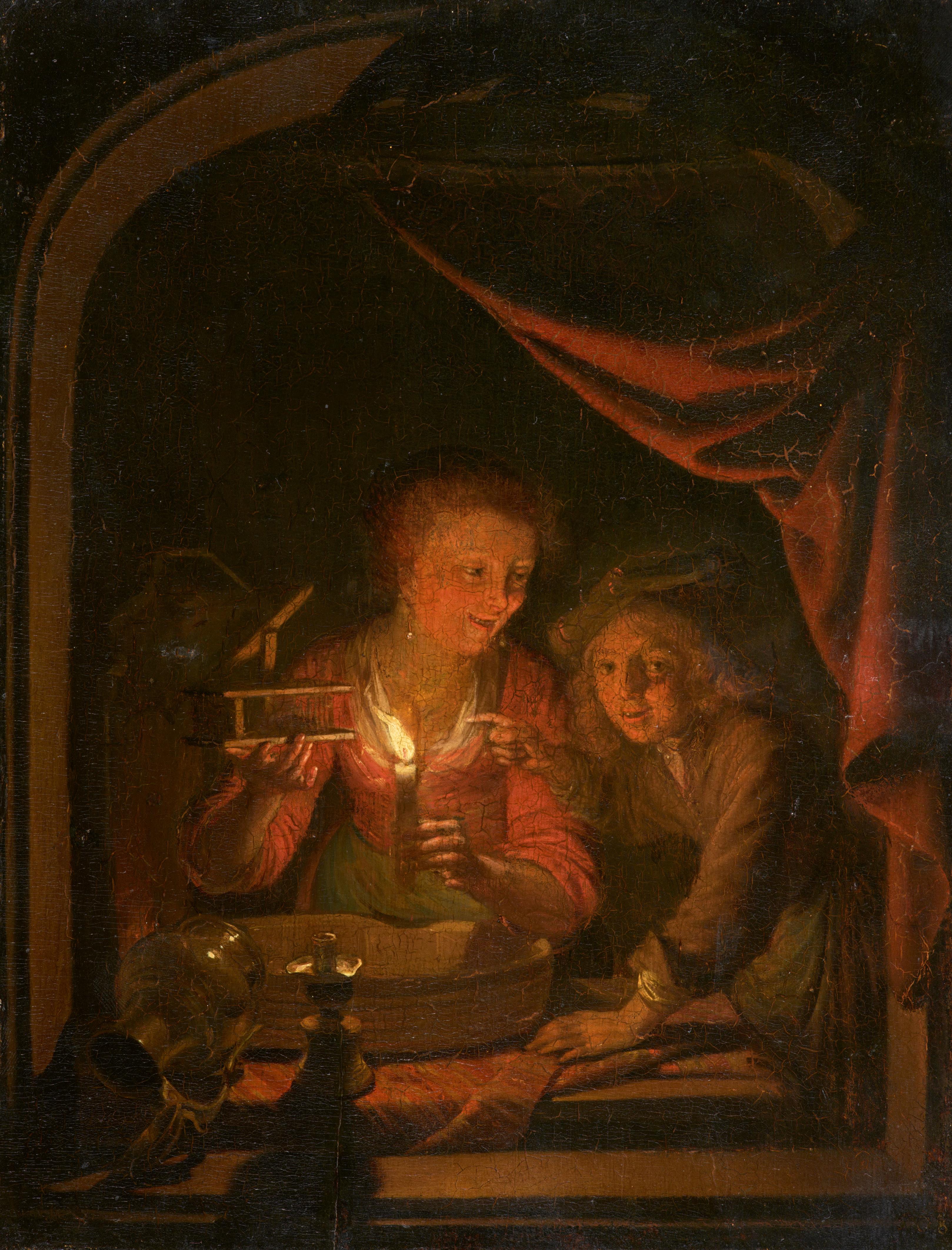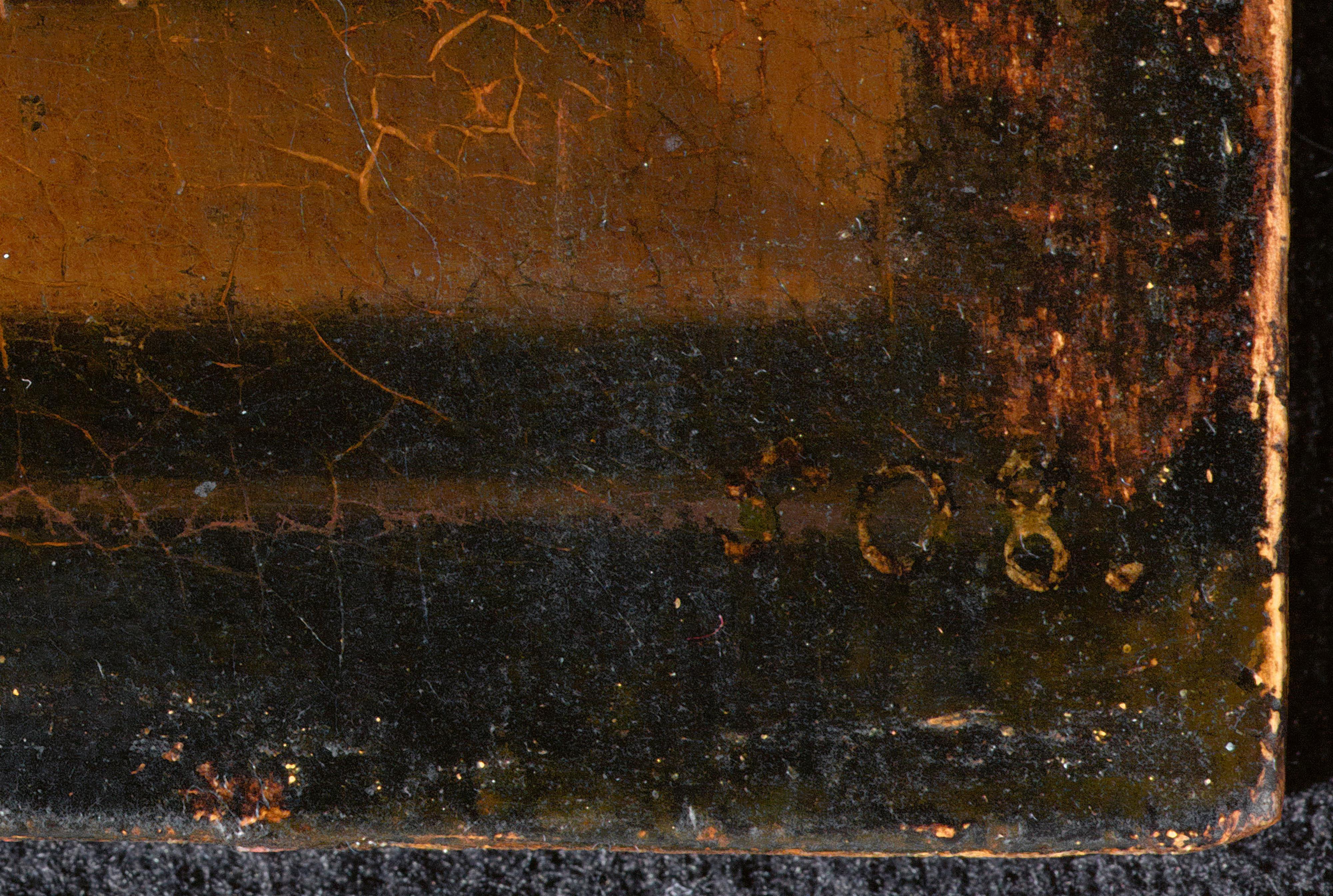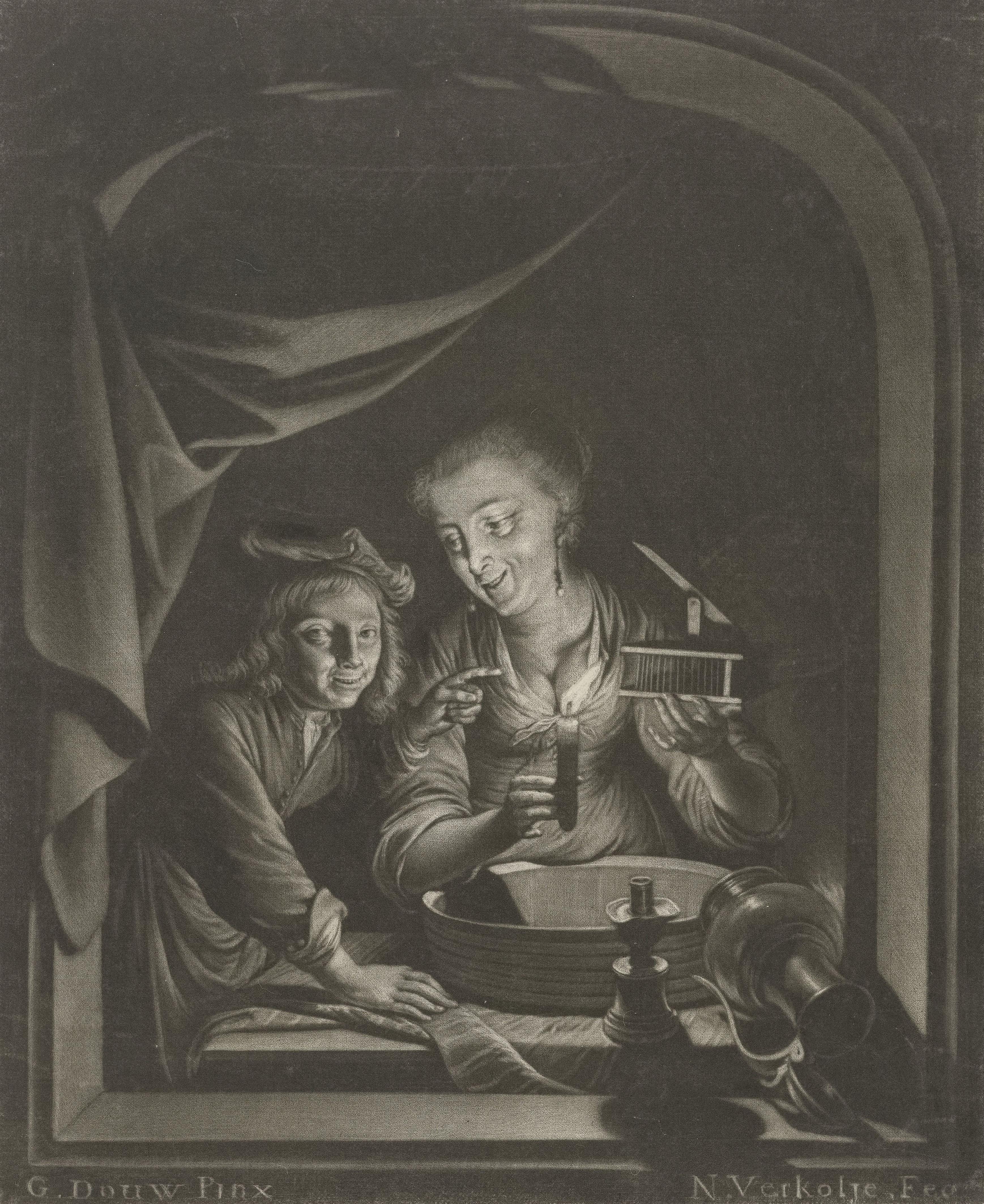Gerrit Dou, attributed to
The Mousetrap
Oil on panel. 26.5 x 20.5 cm.
The whereabouts of this small panel depicting a girl with a mousetrap were unknown from the 1920s until the present day. Only the faint inventory number "508" at the lower right edge of the picture (fig. 2), tells us that it once belonged to one of the most important princely collections of the 18th century, that of Augustus the Strong, Prince Elector of Saxony and King of Poland, where it was attributed to Gerrit Dou himself.
The work depicts a girl holding a mousetrap in one hand and a candle in the other, standing in a stone niche with a drawn red curtain on one side. She looks towards the right at a boy pointing at the mousetrap and looking out at the viewer. The candle in the girl's hand is the only source of light in the picture, and its warm glow illuminates the sparse collection of objects that furnish the scene; a tablecloth, a wooden tub, a candlestick and an overturned pewter jug. The artist brings the intimate arrangement to life through the subtle play of light and shadow and with just a few highlights. The mousetrap was a popular motif in Dutch genre painting of the 17th century; the mousetrap itself, the blazing candlelight, the boy's outstretched finger as well as the fallen pewter jug allude to the dangerous game of (physical) love; the broad grin with which the boy looks at the viewer leaves little doubt as to the painting's meaning.
The work has a varied history. It was reproduced around 1700 by Nicolaas Verkolje in a mezzotint engraving as the work of Gerrit Dou (fig. 1; "G. Douw Pinx. - N. Verkolje Fec."). It then appears in the inventory of Augustus the Strong's painting collection from 1722-1728 under no. 508, where it is listed as follows: "Gerh. Dou / maiden with a mousetrap / 11-9 / du Roy / gallery" (fig. 3). Du Roy refers to Charles du Roy, the Antwerp art dealer from whom Augustus the Strong acquired numerous works for his high-calibre collection of Dutch art. In accordance with the princely collecting practice of the time, the picture gallery included both originals and copies; accordingly, there are two columns in the inventory distinguishing original works from copies ("Or." and "Cop." columns respectively); the mousetrap is listed as a Gerrit Dou original. The painting remained in the Dresden collection - first in the Royal Picture Gallery, then from 1918 in the Old Masters Picture Gallery, to be restituted in 1924 in the course of the settlement between the Free State of Saxony and the House of Wettin (Laabs, op. cit., p. 127). After that, all traces of the work were lost, only a copy surfaced on the international art market last year (auctioned by Im Kinsky, Vienna, 7.7.2021, lot 1106).
The painting's academic fortuna critica is as changeable as its provenance. It is still determined today by the fact that Baer dismissed the attribution to Gerrit Dou in 1990, without, however, being able to see the work in person, as it was lost at the time (Baer, op. cit., no. C 88). After the painting, as shown, was listed in the inventories of the Saxon electors as an original by Gerrit Dou, its autograph was doubted in the inventory catalogues of the 19th century. This changed again after the painting was cleaned in 1901. The entry on the work in the inventory catalogue was once again corrected, and Gerrit Dou was once more named as its author without any restrictions. Two of the leading experts on Dutch painting at the time also recognised the painting as an original work by Gerrit Dou: Firstly, Wilhelm Martin in his catalogue raisonné of 1913 (Martin, op. cit., no. 167). Martin dated the painting to the last creative period of Gerrit Dou between 1670 and 1675, a finding that corresponds to the results of dendrochronological examination, according to which the tree for the panel was felled in 1644 at the earliest, rather between 1650 and 1660. Secondly, Cornelis Hofstede de Groot in the first volume of his Opus Magnum, the "Descriptive and Critical Catalogue of the Works of the Most Outstanding Dutch Painters..." of 1907 (Hofstede de Groot, op. cit., no. 259). As can be seen from Hofstede de Groot's entry on this painting, and as is to be expected in view of the large number of Gerrit Dou's works in the Dresden collection, he saw the "Mousetrap" in the original. Hofstede de Groot also mentions a signature on the painting, "Fully inscribed in the centre", which is now missing - emblematic of the chequered history of this small panel.
Certificate
Dendrochronological examination, Prof. Dr. Peter Klein, Hamburg, 17.10.2021.
Provenance
Acquired by Frederick August I, Elector of Saxony and King of Poland from Charles du Roy for the Electoral Collection. - Royal Picture Gallery in Dresden. - State Painting Collections of Dresden, 1918 - Given to the Wettin Family Association of the Albertine Line in 1924. - West German private collection.
Literature
Johann Adam Steinhäuser: Lit. A et B. Inventaria Sr. Königl. Majestät in Pohlen und Churfürstl. Durchl. zu Sachsen große, wie auch kleine Cabinets und andere Schildereyen etc. etc., 1722-1728, no. 508 (so-called inventory 1722–1728; as an autograph work). - Johann Adam Steinhäuser: Sr. Königl. Majt. in Pohlen und Churfürstl. Durchl. zu Sachßen, Schilderey-Inventaria sub lit. A. et B., 1741–1747 (so-called inventory "vor 1741" / Steinhäusers Inventar; as an autograph work). – Catalog der königlichen Gemälde-Galerie zu Dresden, Dresden, p. 36, no. 276 (Dow, allegedly). - Karl Woermann: Katalog der königlichen Gemäldegalerie zu Dresden, Dresden 1892, p. 552, no. 1721 (after Gerard Dou). - Karl Woermann: Katalog der königlichen Gemäldegalerie zu Dresden, Dresden 1902, p. 554, no. 1721 (as a signed, autograph work). - Cornelis Hofstede de Groot: Beschreibendes und kritisches Verzeichnis der Werke der hervorragendsten holländischen Maler des XVII. Jahrhunderts, vol. 1, Esslingen 1907, p. 424, no. 259 (as an autograph work). - Wilhelm Martin: Gerard Dou, Des Meisters Gemälde, Stuttgart/Berlin 1913, no. 167 (as an autograph work). - Hans Posse: Die Gemälde-Galerie zu Dresden, Dresden 1920, p. 179, no. 1721 (as an autograph work). - Ronni Baer: The Paintings of Gerrit Dou (1613-1675), Diss. New York 1990, no. C 88 (listed under rejected works). – Annegret Laabs: The Leiden Finjschilders from Dresden, exhib. cat. Leiden/Dresden 2001, Zwolle 2001, p. 127.








